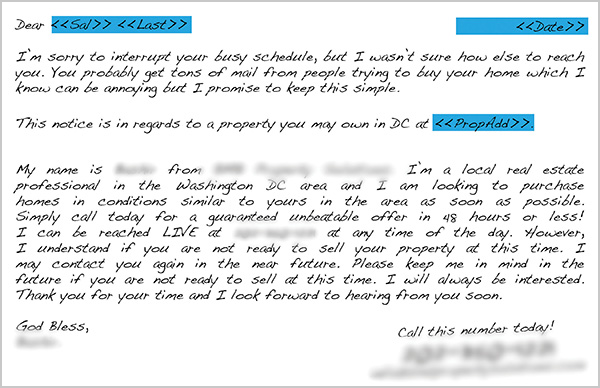Any good real estate investment starts first and foremost with finding the best deal. And that’s where a smart direct mail marketing campaign comes in.
If you’re looking for a direct mail article with general advice — get a good list, mail every month, et cetera — move along. I’m bringing you REAL campaigns with proof of what works for investors nationwide.
My company, PostcardMania, tracks the campaigns of our own clientele in order to share winning strategies with other entrepreneurs. You don’t have to be a client of mine to access this data either. It’s available to everyone.
You get to analyze the data, lists, design and most importantly, the results.
Results like: 502 responses, 13 new homes closed and $100,000 per month in revenue.
I understand that an operation of that size may not be feasible for every investor out there. Quickly taking on 13 new properties is a huge undertaking for more than one reason!
But results like those above highlight the beauty of direct mail marketing. The sky is the limit, but you can, and should, scale to your budget and needs.
So, like I promised, let’s get to it!
Campaign #1: Handwritten Postcards
- Market location: Washington, D.C.
- Mailing list: Seniors age 65+
- Marketing schedule: Two mailings in two months (more than 8,000 cards mailed)
- Return on investment: 316%
- Results: 82 responses and $20,000 in income
This postcard is a great example because it contains a number of elements commonly used in real estate investment postcard marketing because they work.
These elements include:
- Personalized/variable data: This card contains four data sets that are unique to each and every recipient: the salutation (Mr., Ms., etc.), last name, date and property address. Customization like this attracts extra attention by speaking directly to each recipient, and it can increase response rate by more than 100%.
- Handwritten font: This builds on the personalized touch I just mentioned above. Think about it. Don’t you linger a little longer on pieces of mail that don’t look like the typical coupon book?
- A unique mailing list: You’ll have to do a little recon on your competition to figure this one out but, if you can, mail to a list that isn’t likely to be targeted by another investor.
 Campaign #2: Brand Awareness Postcards
Campaign #2: Brand Awareness Postcards
- Market location: Greater Detroit Metro
- Mailing list: Absentee homeowners, single-family dwelling unit (SFDU) individuals who own a home in Metro Detroit but have their property taxes out of state
- Marketing schedule: Three mailings of 1,000 pieces over four months
- Return on investment: 11,658%
- Results: 62 responses, one home bought and sold with a 2nd recently acquired and a 3rd in the pipeline, plus $162,000 in revenue and $37,500 in profit.
 This campaign forgoes the traditional personal letter style in favor of a clean and direct message. Here’s why this one works:
This campaign forgoes the traditional personal letter style in favor of a clean and direct message. Here’s why this one works:
- Crystal-clear messaging: You don’t have to squint an eye to see that this company wants to buy your home. Their message can be absorbed in a blink.
- Repeat mailings: If your budget is small, save on your list by niching-down and reaching the same people a minimum of three times to build momentum. Repeating your message results in greater awareness and better retention.
- Affordable printing: Variable data is an REI mainstay because it works, but it might not work for your budget. A more general campaign like this one can be printed at a much lower cost than the first example.
Campaign #3: Yellow Notice Postcards
- Mailing list: Distressed homeowners
- Marketing schedule: 7,200 postcards per month, mailed every month
- Return on investment: 3,421% after three months of mailing
- Results (after just three months): 502 unique calls, 13 new homes purchased and $96,900 in immediate revenue with year-long projections to generate $60,000–$100,000 per month
I saved the best for last! With results like these, can you blame me?
This campaign might be my favorite because it’s actually the best of both worlds between the two previous campaigns. Let me explain:
- Variable data is featured but scaled back: This lets them save money on printing while still drawing attention to the card.
- Yellow letter format proves itself again and again: This one does it even better by jumping right to a “third notice,” which creates a leap in urgency.
- Clear, no-strings call to action: This company uses a tried and true “listen to my recorded message” call to action that works because it is a very low-commitment method to capture a lead — and a phone number at that! I’ll take phone number leads all day over just an email.























Some great observations and ideas in there. For ‘handwritten’ folder cards (we can automate sending and create your own handwriting) you might want to check out Thankster.com. Our brokers have great results with personalized, outreach. Could nicely complement Postcardmania’s postcards.